One trip, three islands. Turquoise waters are just the beginning.

The turquoise water of the Blue Lagoon on Comino Island in the Maltese archipelago isn't just a tourist brochure slogan. Its blue-green hue literally stands out against the deeper, darker water. It's visible from the plane window as we approach the airport.
But there are still other colors to discover in Malta – the honey-colored facades of buildings, the white of sea salt and marble in baroque churches.
Because even if we were tempted to come by offers of hotels overlooking the sea or majestic cliffs, we also learn about the history of three inhabited islands: Malta, Gozo, and Comino. They are relatively small – the former has a population similar to Gdańsk, the latter to Kołobrzeg, and on Comino… a single family lives.
When we stop at the viewpoint at Xwejni Bay in Gozo, we immediately see one of the most photographed sites on the island – shallow, natural "compartments" carved into the rocks, resembling a checkerboard square: salt pans. Local residents maintain a tradition of extracting salt through evaporation dating back over three centuries. It's a tourist attraction that reflects the island's distant past. Even in ancient Roman times, salt was a valuable commodity.
Valletta, or the stunning baroqueSalty seawater laps against the rocks of Rocky Beach, a stretch of coastline at the foot of Fort St. Elmo in the island's capital, Valletta. The Knights of the Order of Malta, present on the island since 1530, moved their headquarters from Birgu after losing their seat on Rhodes.
Today, Valletta – the smallest capital in Europe, situated on a peninsula jutting into the sea – is a wealth of Baroque architecture and 320 monuments.
As we tour the Grand Master's Palace – the former residence of the Grand Masters of the Order and today the seat of the President of Malta – from the sunny Prince Alfred Courtyard, we can see the team working on renovating the building's rooms . A national pride and a must-see for military enthusiasts is the Armoury, which displays the Grand Masters' armor and a rich collection of weapons. The details are also captivating – especially the frescoes on the ceilings of the main corridors, which create a sense of depth, as well as other wall paintings.
A visit to Valletta is a must-see, as is the famous Co-Cathedral of St. John, which further underscores the significant role the monks played on the island and the wealth they commanded. This Baroque church attracts visitors not only for the Caravaggio works displayed in the oratory. Due to its stunning gold and marble, it is now not only a church but also a tourist attraction.
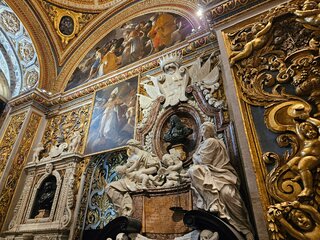
The funerary monuments of the Order's Grand Masters give the impression of being placed on a pedestal, almost like saints. One is so large that it couldn't fit into one of the eight langue chapels—the order's linguistic groups, which competed with each other for the beauty and splendor of each.
At midday, I look for a place to escape the sun's rays – it's already very warm here in May. The best time to visit the Lower Barakka Gardens park, located on St. Christopher's Bastion (part of the city's fortifications), is then to relax on one of the many benches facing the sea.

From the upper level of the bastion, one can see the Siege Bell monument below, and in front of it, the statue of the unknown soldier resting on a catafalque, commemorating those who died in World War II between 1940 and 1943. Malta's wartime history is showcased at the National War Museum, located in Fort St. Elmo. Several rooms feature an animation dedicated to the Great Siege of Malta in 1565 and exhibits from the 20th century, including the British fighter plane "Faith," which defended the island from 1940 to 1942. We will also learn about the Victory Kitchens—community kitchens where residents could request food rations. These were essential when Germany and Italy were sinking convoys of ammunition and food reaching the British base in the Mediterranean, and famine was becoming increasingly acute. A restored sign marking such a place can be seen at the intersection of Melita Street and Merchants Street.
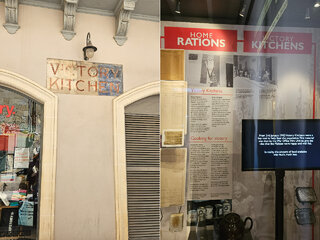
Before we get to know the capital of Malta from its less historical side, let's go to the north of the island.
The Red Tower, like something out of a pirate fairy taleWe stop at the Red Tower (St. Agatha's Tower) in the northeastern part of the island. Its vibrant color makes it look a bit like something out of a fairy tale, but in the past it served a significant function – it was one of the watchtowers built during the reign of Grand Master Jean Paul Lascaris. This defensive system was designed to protect Malta from North African pirates and Turkish attacks. Although never attacked, it surrendered to Napoleon's French army. Today, it is a small museum run by the non-profit organization Din l-Art Ħelwa (the name comes from the words of the Maltese national anthem, "this beautiful land"). It also offers a superb vantage point from which you can see the islands of Gozo and Comino. Admission to the Red Tower costs approximately 10 złoty.
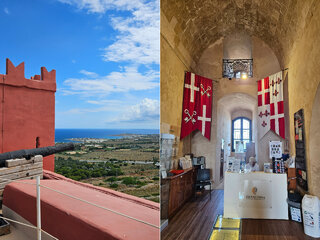
From here, it's a short drive to the Ċirkewwa ferry terminal, where we'll sail to the island of Gozo. Along the way, we pass tourists relaxing on the sandy beach of Mellieha Bay. Less than half an hour into the cruise, we're greeted by the sight of the church in Mġarr, boats in the harbor, and rocks jutting out from the clear water.
Gozo – greener and less developed – has an equally rich history, although… I admit that I initially succumb to its holiday charm. After the ferry docks, you immediately feel the pace slow down here.
It's no coincidence that many Maltese people buy second homes on this quieter island. Locals and tourists alike enjoy relaxation in the fishing village of Marsalforn in the northern part of the island, among other places. Gozo's most important port until the 16th century, today it has a strong tourist profile, and around its bay you'll find diving centers, including a Polish one. Here, you can dine at the family-run Il-Kartell restaurant, located right by the sea. Sailboats bob in the distance.
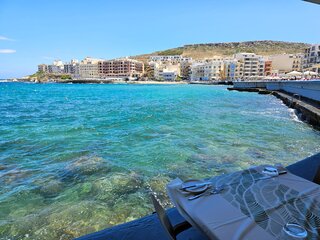
Gozo's maritime history is also carved in stone, including on the wall of the Cathedral of the Assumption of the Blessed Virgin Mary in the island's capital, Rabat (Victoria). The photo shows an 18th-century galley carved into the cathedral wall – a way for sailors to express their gratitude for successfully reaching the island, or for having successfully weathered a storm or pirate attack. Hundreds of such graffiti can be found throughout the Maltese islands. They mainly date from the 17th to the early 19th centuries. The Malta Ship Graffiti Project maintains them, gathering knowledge about them and the circumstances in which they were created.
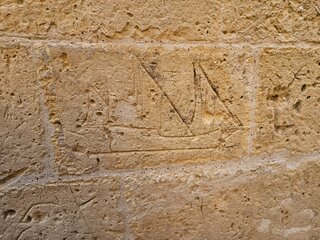
Malta's sister island also boasts its own fortifications – the hilltop fortress city of Rabat, the Citadel. This car-free zone allows you to stroll through the centuries-old city. Older buildings – dating back to the reign of the Aragonese rulers – are located in its northern part.
The citadel witnessed a dramatic turn in Gozo's history. In 1551, the Ottoman Turks conquered the island within days and took its inhabitants prisoner. Their task was no easy one – by then, the medieval walls of the citadel were no longer an effective defense. It wasn't until the late 16th century that the Hospitallers initiated a thorough renovation, which resulted in the incorporation of the older section into a modern fortress.
From the hill there is a beautiful view of the newer part of the city that has grown around the fortress and its green surroundings.
In the near future, Gozo will be able to tell its story more fully with a new museum on the outskirts of Rabat. The construction plan had to be modified after Roman ruins and a quarry were discovered there a few years ago. These have been incorporated into the design of the new site. The museum is scheduled to open in 2026.
Phone booths that no longer make callsThe period of British rule in Malta (1800-1964) left behind not only a second official language – English. Telephone booths, which blend seamlessly into the landscape of golden buildings and vibrant pink oleanders, are also a reminder of this period. Some, as in Great Britain, were converted into public libraries – such as the one in Gudja. It can be found on Raymond Caruana Street, opposite the police station.
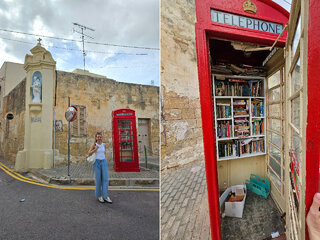
When visiting Malta, you often feel as if you're in southern Italy. The low-rise stone buildings in its villages and the low-lying landscape make it seem as if time has stood still. This is not the case in Valletta, which bustles with the rhythm of tourism and organized tours. Old-fashioned signs blend seamlessly with the city's classic architecture. Here, you'll find trendy Michelin-starred restaurants and the Is-Suq tal-Belt market, which houses a supermarket downstairs and a modern food court upstairs. In the narrow streets, you'll watch out for maneuvering delivery trucks, and while strolling, you'll encounter street fruit stands. You'll also find contemporary boutiques, such as Designers Boutique Valletta, which offers clothing and handicrafts, at 14 Old Theatre Street.
When the hustle and bustle gets a bit tiring, the sea is always just a few steps from the old town… although on the way back, we'll be climbing uphill. The peninsula that the Hospitallers chose as their headquarters is hilly. In the capital, the best place to catch your breath is the rocky coast, accessible by steps from Triq-Il Mediterran. It's a beautiful and not very crowded spot – you're almost guaranteed to spot a lizard slithering between the rocks. From the steps, you can head left to the rocky "beach" of Rocky Beach and walk around Fort St. Elmo.
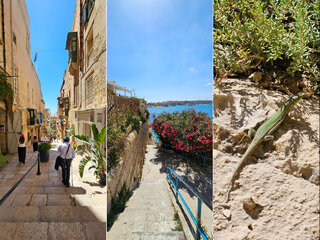
As evening falls, strolling down the main street, Republic Street, without the crowds, becomes much more pleasant. Tourists then move to St. Lucias Street, adorned with lights and lined with cafes and restaurants. The illuminated Triton Fountain, located near the city gate, looks much more atmospheric. Yes, its style is reminiscent of the famous Roman fountain... but Malta, so small yet so full of seaside nooks and crannies, has its own distinct story to tell.
We were invited to this trip by the Malta Tourism Organization. The organizer did not interfere with the content of this text. I would like to thank Vincent Zammit, a guide and lecturer at the Institute of Tourism Studies in Malta, for his consultation.
Read also: 13 Piglets and a Lost Work of Art. Here I Discovered the Secrets of Malta. Read also: Honey Island, a 3-Hour Flight Away. Pearls Like These Grow on Its Trees
Wprost





